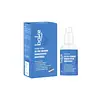What's inside
What's inside
 Key Ingredients
Key Ingredients

 Benefits
Benefits

 Concerns
Concerns

 Ingredients Side-by-side
Ingredients Side-by-side

Water
Skin ConditioningGlycerin
HumectantAloe Barbadensis Leaf Juice
Skin ConditioningPEG-8 C12-18 Alkyl Ester
EmulsifyingLecithin
EmollientDimethicone
EmollientHelianthus Annuus Seed Oil
EmollientSodium Polyacrylate
AbsorbentXylitol
HumectantCaprylic Acid
CleansingGlyceryl Stearate
EmollientRosa Damascena Flower Water
MaskingZinc PCA
HumectantSodium Hyaluronate
HumectantPolyglutamic Acid
Skin ConditioningBetaine
HumectantTocopherol
AntioxidantHyaluronic Acid
HumectantHydroxyethyl Urea
HumectantCeramide AP
Skin ConditioningLactic Acid
BufferingAllantoin
Skin ConditioningMandelic Acid
AntimicrobialOat Amino Acids
Skin ConditioningPotassium Azeloyl Diglycinate
Skin ConditioningLysolecithin
EmulsifyingNiacinamide
Smoothing3-O-Ethyl Ascorbic Acid
Skin ConditioningPhenethyl Alcohol
MaskingBisabolol
MaskingCaprylhydroxamic Acid
Tocopheryl Acetate
AntioxidantPhytic Acid
Caprylyl Glycol
EmollientSodium Benzoate
MaskingPotassium Sorbate
PreservativePhenoxyethanol
PreservativePanthenol
Skin ConditioningEthylhexyl Methoxycinnamate
UV AbsorberButyl Methoxydibenzoylmethane
UV AbsorberBenzophenone-3
UV AbsorberPhospholipids
Skin ConditioningButylene Glycol
HumectantMethyl Undecylenate
PerfumingTasmannia Lanceolata Fruit/Leaf Extract
AntioxidantWater, Glycerin, Aloe Barbadensis Leaf Juice, PEG-8 C12-18 Alkyl Ester, Lecithin, Dimethicone, Helianthus Annuus Seed Oil, Sodium Polyacrylate, Xylitol, Caprylic Acid, Glyceryl Stearate, Rosa Damascena Flower Water, Zinc PCA, Sodium Hyaluronate, Polyglutamic Acid, Betaine, Tocopherol, Hyaluronic Acid, Hydroxyethyl Urea, Ceramide AP, Lactic Acid, Allantoin, Mandelic Acid, Oat Amino Acids, Potassium Azeloyl Diglycinate, Lysolecithin, Niacinamide, 3-O-Ethyl Ascorbic Acid, Phenethyl Alcohol, Bisabolol, Caprylhydroxamic Acid, Tocopheryl Acetate, Phytic Acid, Caprylyl Glycol, Sodium Benzoate, Potassium Sorbate, Phenoxyethanol, Panthenol, Ethylhexyl Methoxycinnamate, Butyl Methoxydibenzoylmethane, Benzophenone-3, Phospholipids, Butylene Glycol, Methyl Undecylenate, Tasmannia Lanceolata Fruit/Leaf Extract
Ingredients Explained
These ingredients are found in both products.
Ingredients higher up in an ingredient list are typically present in a larger amount.
Aloe Barbadensis Leaf Juice comes from leaves of the aloe plant. Aloe Barbadensis Leaf Juice is best known for helping to soothe sunburns. It is also anti-inflammatory, moisturizing, antiseptic, and can help heal wounds.
Aloe is packed with good stuff including Vitamins A, C, and E. These vitamins are antioxidants, which help fight free-radicals and the damage they may cause. Free-radicals are molecules that may damage your skin cells, such as pollution.
Aloe Barbadensis Leaf Juice also contains sugars. These sugars come in the form of monosaccharides and polysaccharides, folic acid, and choline. These sugars are able to help bind moisture to skin.
It also contains minerals such as calcium, 12 anthraquinones, fatty acids, amino acids, and Vitamin B12.
Learn more about Aloe Barbadensis Leaf JuiceCeramide AP is formally known as Ceramide 6.
Ceramides are intercellular lipids naturally found in our skin that bonds dead skin cells together to create a barrier. Having a strong skin barrier leads to more firm and hydrated skin.
They are known for their ability to hold water and thus are a great ingredient for dry skin. By bolstering the skin ceramides act as a barrier against irritating ingredients. This can help with inflammation as well.
If you would like to eat ceramides, sweet potatoes contain a small amount.
Read more about other common types of ceramides here:
Ceramide NP
Ceramide EOP
Glycerin is already naturally found in your skin. It helps moisturize and protect your skin.
A study from 2016 found glycerin to be more effective as a humectant than AHAs and hyaluronic acid.
As a humectant, it helps the skin stay hydrated by pulling moisture to your skin. The low molecular weight of glycerin allows it to pull moisture into the deeper layers of your skin.
Hydrated skin improves your skin barrier; Your skin barrier helps protect against irritants and bacteria.
Glycerin has also been found to have antimicrobial and antiviral properties. Due to these properties, glycerin is often used in wound and burn treatments.
In cosmetics, glycerin is usually derived from plants such as soybean or palm. However, it can also be sourced from animals, such as tallow or animal fat.
This ingredient is organic, colorless, odorless, and non-toxic.
Glycerin is the name for this ingredient in American English. British English uses Glycerol/Glycerine.
Learn more about GlycerinTocopherol (also known as Vitamin E) is a common antioxidant used to help protect the skin from free-radicals and strengthen the skin barrier. It's also fat soluble - this means our skin is great at absorbing it.
Vitamin E also helps keep your natural skin lipids healthy. Your lipid skin barrier naturally consists of lipids, ceramides, and fatty acids. Vitamin E offers extra protection for your skin’s lipid barrier, keeping your skin healthy and nourished.
Another benefit is a bit of UV protection. Vitamin E helps reduce the damage caused by UVB rays. (It should not replace your sunscreen). Combining it with Vitamin C can decrease sunburned cells and hyperpigmentation after UV exposure.
You might have noticed Vitamin E + C often paired together. This is because it is great at stabilizing Vitamin C. Using the two together helps increase the effectiveness of both ingredients.
There are often claims that Vitamin E can reduce/prevent scarring, but these claims haven't been confirmed by scientific research.
Learn more about Tocopherol